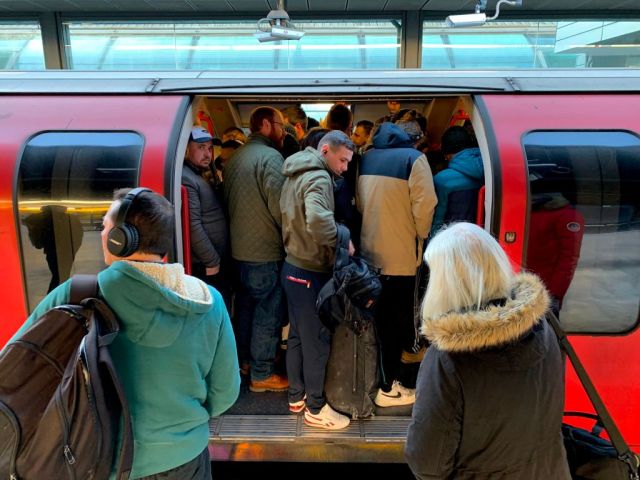The Central Line Credit:Daniel Leal-Olivas /AFP/ Getty

The shock of the Covid-19 lockdown has hit transport systems like a heart attack. Don’t expect them to recover quickly. It’s obvious that airlines will be on life-support for years. What is less well-understood is that, as discussion turns to reopening the economy, urban public transport is now looking at the equivalent of chronic heart disease, with lower demand, but even lower capacity.
As lockdowns ease, discretionary travel will be discouraged; home-working will remain ubiquitous, business travel will be almost non-existent. The economy will limp along for years, suffering first from the friction of social distancing, then from the destruction of everyone’s balance sheets: individuals, companies, charities, public sector and government. A few years of loose fiscal and monetary policy is likely to be followed by another decade of austerity.
Lower overall transport demand will be exacerbated by a dramatic shift away from trains and buses. Until the arrival of a vaccine — One year? Two? — those who are out and about are going to be scared of crowded vehicles. And with good reason: over 100 transport workers have already died of Covid-19 in the US, 39 in London by 3 May. Data from China shows that as the lockdown was eased, private car use surged to a 66% share, from 34% pre-Covid, with public transport use seeing an almost identical decrease in usage.
For the foreseeable future, public transport operators are going to have a massive capacity problem, particularly at rush hour. The most cursory look at the average bus or train carriage shows that if you really want to maintain strict social distancing on board, you have to run at 15% to 20% of peak capacity — with no one standing and only every fourth seat in use. The London Strategic Coordination Group has recently woken up to the problem, estimating in a confidential report that the Tube’s capacity could be reduced to 15% of normal levels, and buses to 12%.
If capacity is allowed to shrink by more than demand, cities can expect dystopian years of congestion, gridlock, air pollution, emissions and parking shortages. The ability of the economy to bounce back from the Covid-19 lockdown could be rate-limited by that most prosaic of things, a lack of urban transport capacity.
Three things need to be done, then. And done quickly:
First, authorities need to rebuild trust in mass transit. People need to feel safe travelling on trams, trains and buses even before the virus has completely disappeared. Visibly step up cleaning regimes; issue staff with PPE; mandate the wearing of face coverings by passengers; increase capacity to the greatest extent possible; and restrict passenger numbers so that social distancing can be rigorously observed.
Second, promote active travel and micro-mobility, not as a nice-to-have for sustainability or health reasons, but as a public priority vital to keeping cities moving and enabling robust economic activity. Reward people for walking and cycling; remove barriers to scooter and e-bike use; massively increase rental bike capacity; create temporary bike and walking lanes; and set up bike and scooter parking and charging locations. Cap the numbers of taxis and private hire vehicles — which will otherwise soar — and discourage the use of private cars.
Third, find creative ways to increase capacity. Obviously, this means increasing the volume and frequency of public transport services, but in many cases the capacity to do so is limited — London’s Victoria Line, for example, was already running a train every 100 seconds during rush hour before Covid-19. To supplement it, therefore, integrate private sector transport and smart mobility providers, many of whom have been idled by the impact of Covid-19 on the travel and hospitality industry.
A number of the big names in smart mobility – Uber, Via, Moia – have the ability to initiate dynamic bus and minibus services immediately. As soon as Covid-19 hit, a young London-based start-up I chair, Zeelo, pivoted from providing commuter coach services to out-of-town employers to providing safe transport for critical workers. Zeelo and others could recruit and manage thousands of coaches to supplement public transport services on the busiest routes. Driverless shuttle providers such as Navya and EasyMile could provide safe services on campuses, business parks and shopping streets.
Not only would these smart mobility services add capacity but, because they are fully digital, they are ideally placed to supporting the “test and trace” phase of pandemic response – subject of course to privacy controls.
When the Covid-19 pandemic eventually passes, life will return to normal. Not the old normal, but one in which the public can again go about its life without fear of catching a deadly disease. Some of the behaviour changes like home working, video-conferencing, remote medicine and education are proving popular, and people will demand that elements of them continue in place.
Even so, the likelihood is that within a few years of the final Covid-19 case, transport demand will have bounced back to the levels of 2019 and beyond. However, transport authority budgets will remain under far too much pressure to respond by adding capacity in the traditional way, by building infrastructure and adding services. Public transport’s peak-time capacity problem is here to stay.
Until Covid-19, the blurring of boundaries between public and private transportation and the integration of smart mobility services into daily commutes was the stuff of specialist transport and planning blogs. That is about to change.
When historians look back on the current era, the death of the post-war public transport paradigm will not be seen as the arrival of Uber, but the 2020 Covid-19 pandemic. A new, smarter form of urban transport will have to be born.










Join the discussion
Join like minded readers that support our journalism by becoming a paid subscriber
To join the discussion in the comments, become a paid subscriber.
Join like minded readers that support our journalism, read unlimited articles and enjoy other subscriber-only benefits.
Subscribe